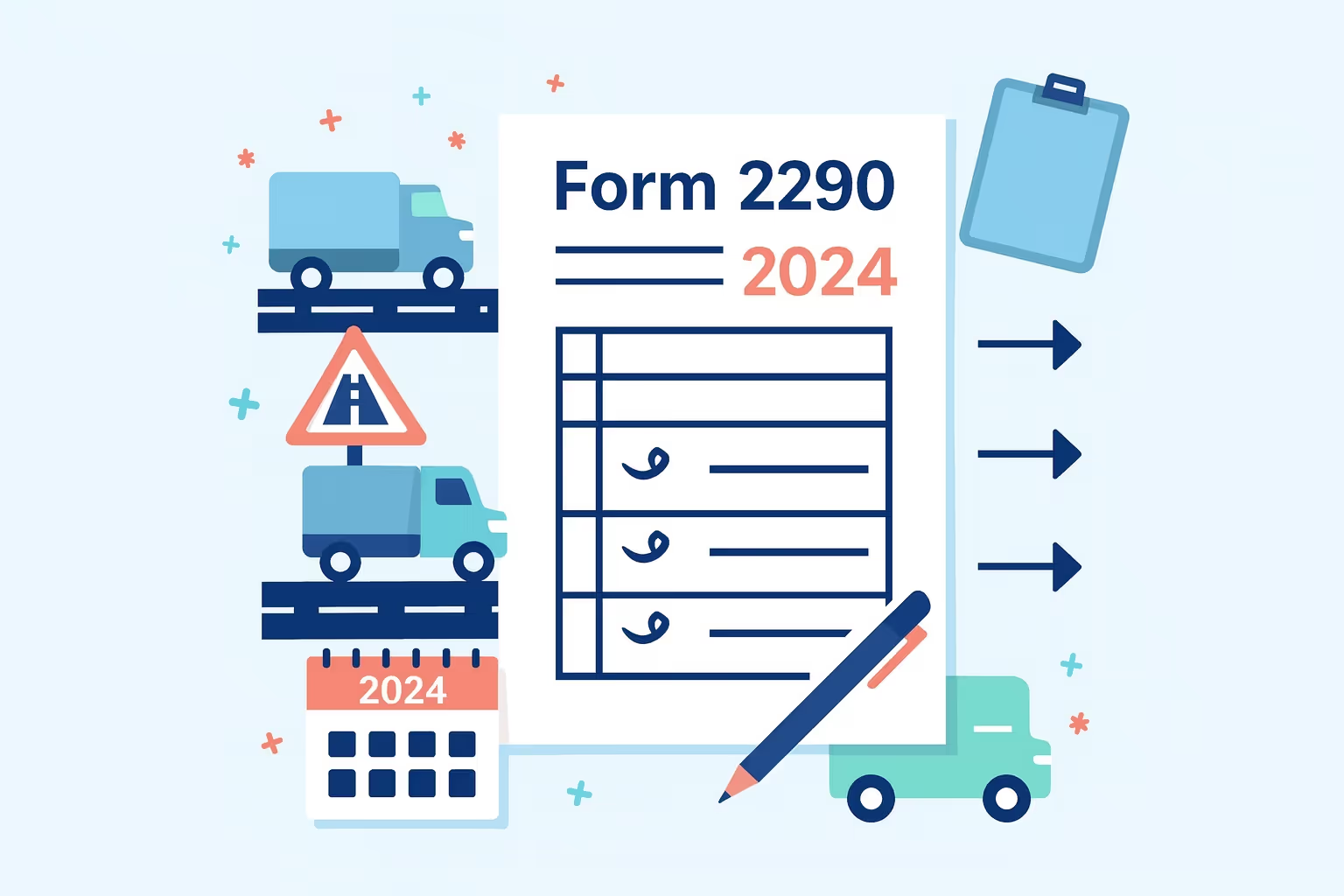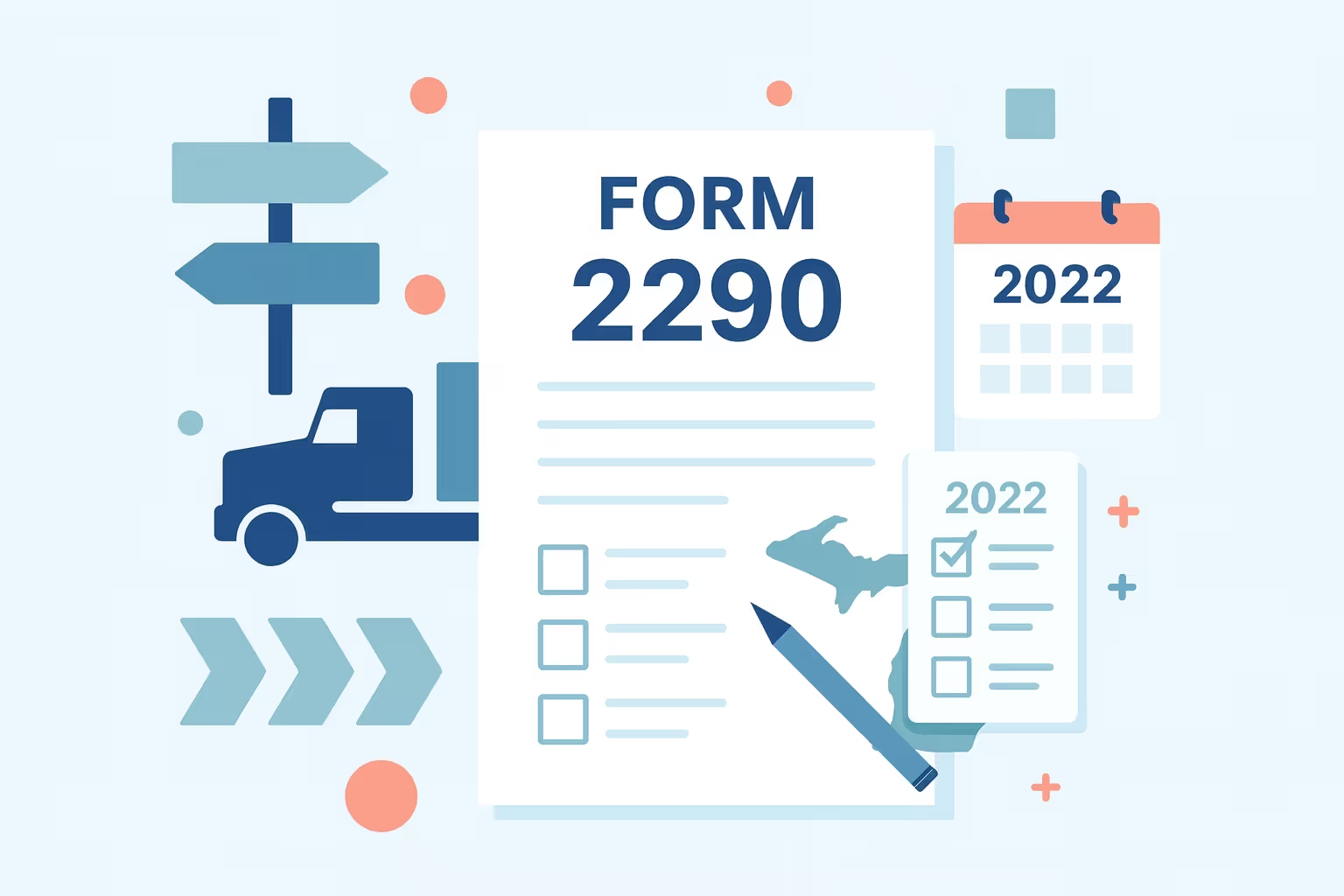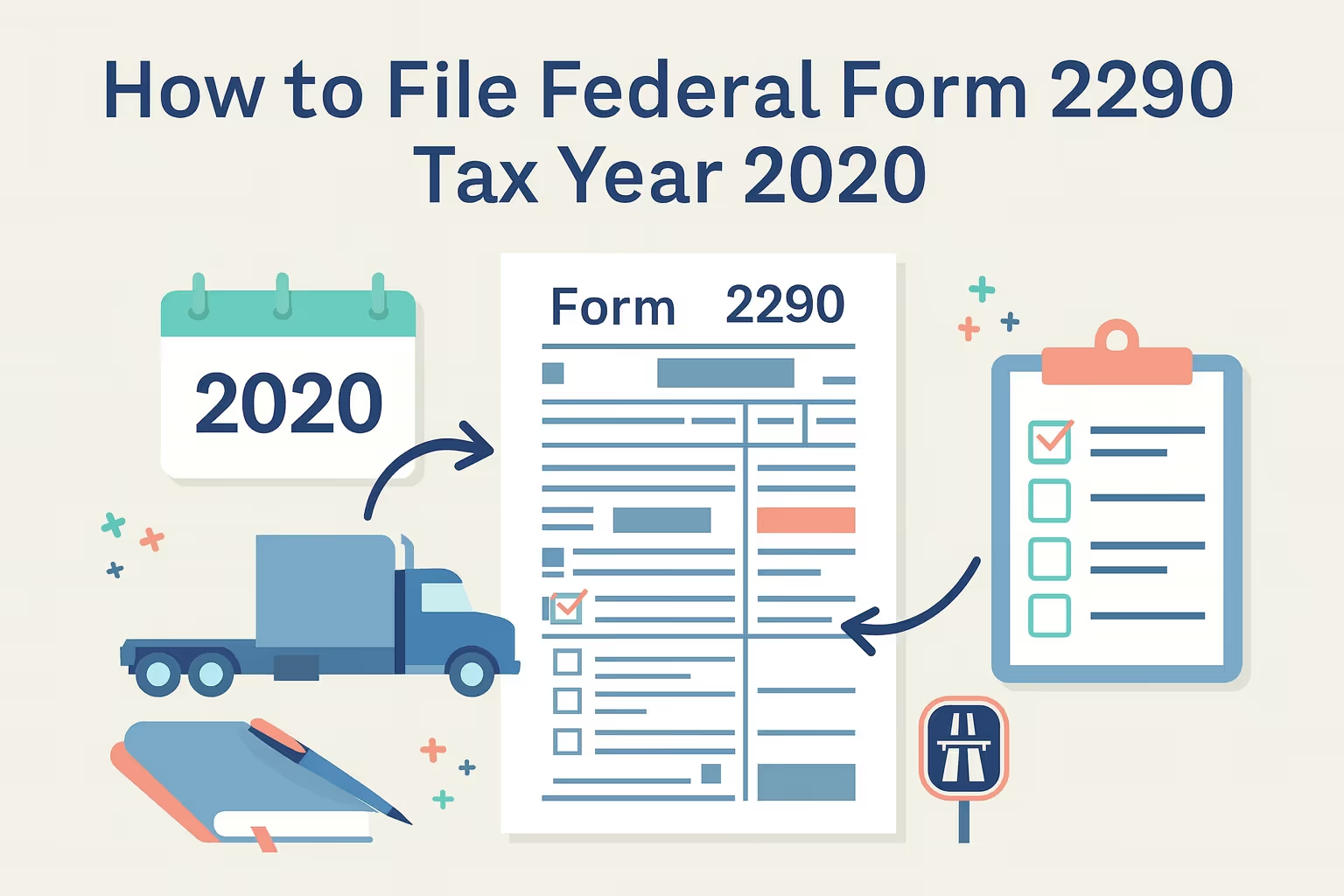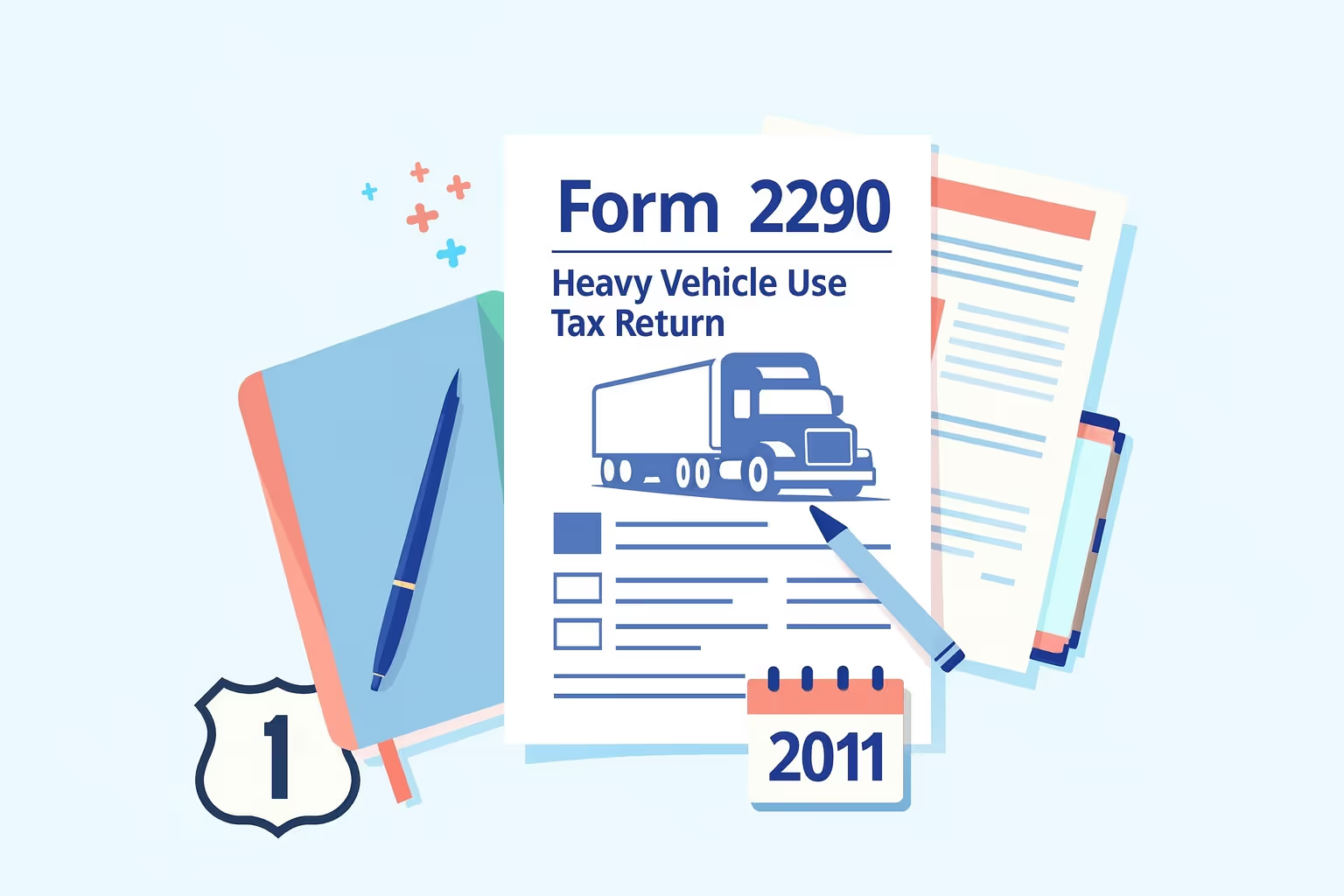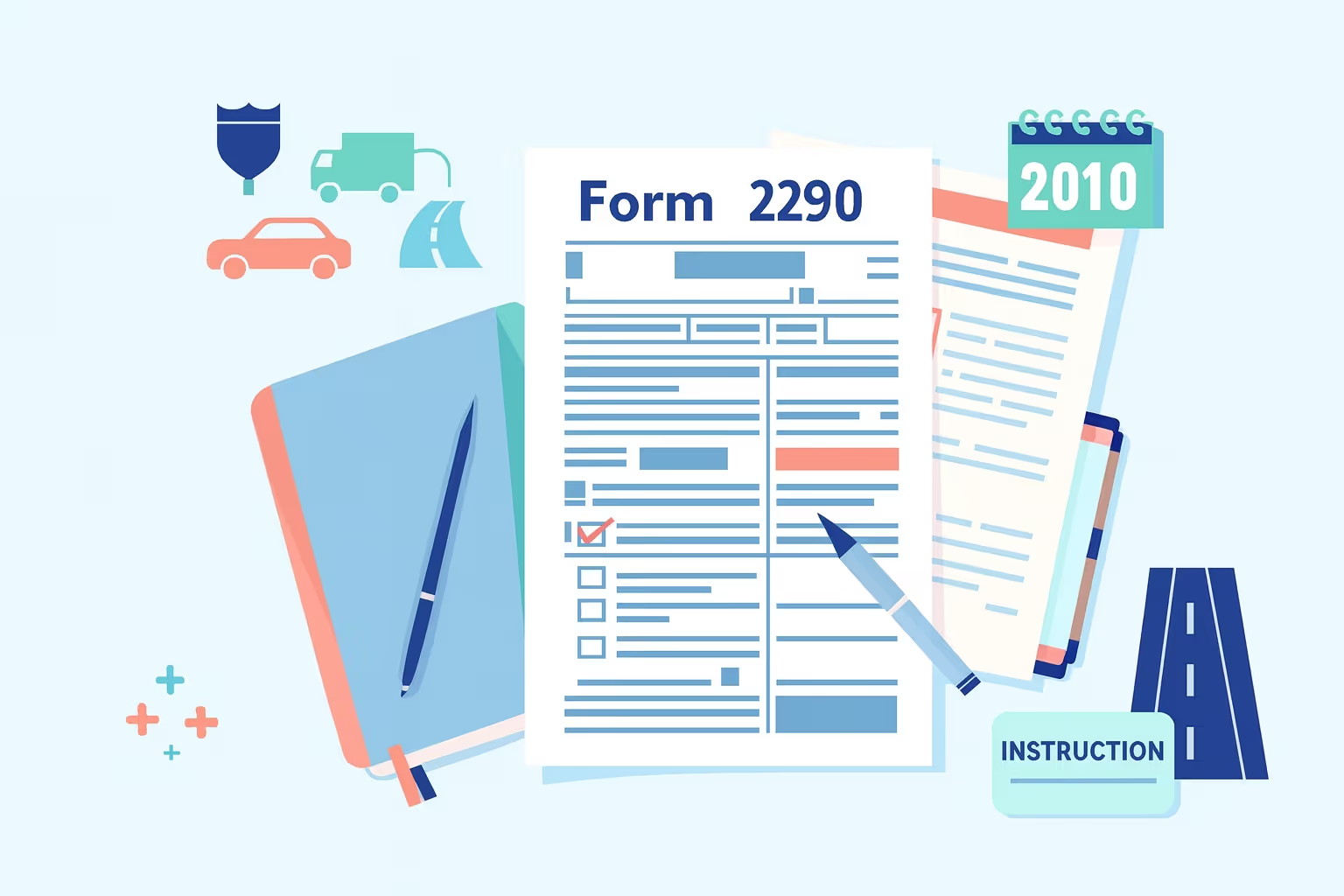Form 2290 2012 Instructions: Highway Vehicle Use Tax
Truck owners and operators of heavy highway vehicles that travel on public highways must complete IRS HVUT Form 2290 to stay compliant with federal excise tax requirements. This vehicle use tax return applies when a vehicle’s taxable gross weight reaches 55,000 pounds or more. The tax helps fund the maintenance and improvement of national highways used by heavy vehicles throughout the year.
The 2012–2013 tax period runs from July 1, 2012, through June 30, 2013. Taxpayers must figure and pay the tax based on each vehicle’s weight category, mileage use, and the month of first highway use. The Internal Revenue Service records each completed return as an official filing. Employers, agricultural operators, and fleet owners should ensure all documents related to each registered vehicle are accurate before submitting their tax forms.
The IRS provides the official Form 2290 page, which includes filing guidance, eligibility details, and downloadable forms to help taxpayers complete their returns accurately. A clear understanding of the process helps filers reduce errors, confirm eligibility, and maintain compliance with all federal requirements during the filing period.
Who Must File Form 2290
Taxpayers must file Form 2290 when they operate heavy highway vehicles that meet the federal excise tax filing threshold. This section defines who is responsible for submitting the vehicle use tax return, outlines the taxable gross weight requirements, and clarifies how ownership, highway use, and mileage limits impact filing obligations. Understanding these conditions helps truck owners meet their filing responsibilities and maintain compliance with IRS requirements.
Taxpayers Required to File
- Eligibility Criteria: Taxpayers must file when they own or operate a registered heavy highway vehicle under their name. The Internal Revenue Service requires all taxpayers with qualifying vehicles to submit a return, including individuals, corporations, partnerships, and limited liability companies.
- Business Types: The filing rule applies to commercial carriers, agricultural operators, and fleet owners with vehicles that use public highways during the tax period. Nonprofit and government entities are also responsible for ensuring that their vehicles meet the taxable weight requirement.
- Ownership Changes: If a used taxable vehicle was acquired, sold, or transferred, the new owner becomes responsible for reporting the acquisition and paying the associated tax for the period of highway use.
Weight Threshold and Classification
- Taxable Gross Weight: Vehicles with a gross weight of 55,000 pounds or more must be reported. This total includes the unloaded vehicle, attached trailer, and maximum load customarily carried.
- Exclusions: The driver’s weight is not included in the gross weight calculation.
- Heavy Vehicle Categories: Weight categories determine how taxpayers figure and pay their federal excise tax. Each category has its own rate, which reflects the weight classification and intended usage.
Highway Use and Mileage Limits
- Highway Use Definition: A vehicle is subject to tax once it is operated on public highways. Roads maintained with public funds, including federal, state, and local systems, are considered taxable routes.
- Mileage Use Limit: The law allows claim suspension for vehicles expected to operate 5,000 miles or less, or 7,500 miles or less for agricultural vehicles.
- Suspended Vehicles: When a vehicle falls within the mileage limit, taxpayers may complete a suspension statement and file the return without paying the full tax. Accurate mileage tracking ensures continued eligibility.
Exempted and Special-Use Vehicles
- Vehicles Exempted: Pickup trucks, panel trucks, and vans below the weight threshold are not subject to the heavy vehicle use tax.
- Agricultural Vehicles: Qualifying farm vehicles receive extended mileage limits and reduced filing obligations if they remain within specified limits.
- Stolen or Destroyed Vehicles: If a vehicle is stolen or permanently destroyed before meeting the mileage requirement, a credit may apply toward future tax liabilities.
Carefully reviewing each requirement ensures that taxpayers determine eligibility accurately and maintain proper records for each vehicle, thereby ensuring compliance with relevant regulations. Before starting the filing process, it’s essential to gather all necessary documents and verify each detail to ensure a smooth and accurate submission.
What You Need Before Filing
Preparing the correct documents in advance helps ensure accuracy and timely processing. Each taxpayer must verify business identifiers, vehicle details, and weight classifications before entering data into the IRS HVUT Form 2290. Gathering every required record prevents delays and supports compliance with Internal Revenue Service requirements for heavy highway vehicles.
Employer Identification Number and Business Information
Taxpayers must use a valid Employer Identification Number when submitting their return. The IRS does not accept Social Security Numbers for the HVUT filing process. Your legal business name, address, and contact details must match existing IRS records to avoid rejection. Verifying these details in advance helps create a clear connection between your federal excise tax filing and your registered entity.
Every taxpayer, including individuals operating as sole proprietors, must confirm that the Employer Identification Number is active and linked to their business account. New business owners can apply for an EIN through the IRS website before completing any section of Form 2290. Keeping a record of prior filings and documents related to previous tax periods can also help confirm consistency across returns.
Vehicle Identification and Weight Records
Each return must list the correct Vehicle Identification Number for every taxable vehicle. VIN accuracy is critical because it uniquely identifies each unit that is subject to the heavy vehicle use tax. Typographical errors in this field can prevent vehicle registration or delay the IRS from issuing the stamped Schedule 1. Taxpayers should verify each VIN against the registration certificates or manufacturer documentation to confirm accuracy.
Taxpayers must also calculate each vehicle’s taxable gross weight to determine and pay the correct amount of federal excise tax. The weight includes the vehicle’s unloaded total, trailers customarily attached, and the maximum load it can carry on public highways. Accurate calculations help prevent incorrect tax assessments and potential amendments later in the filing period.
Supporting Documentation and Recordkeeping
Truck owners should maintain files containing all documents related to their fleet, including ownership records, purchase agreements, and prior year forms. Weight certificates, mileage logs, and suspension statements should remain readily available to confirm eligibility for claim suspension if applicable. Organized recordkeeping supports transparency and simplifies future filings.
Having all the required materials ready before preparing Form 2290 streamlines the filing process and reduces the likelihood of errors. Once all documents are prepared, taxpayers can begin completing the form by following each step carefully to ensure every detail is recorded correctly.
Step-by-Step Form 2290 Completion Guide
Completing IRS HVUT Form 2290 requires careful attention to detail and accurate data entry. Each section of the vehicle use tax return captures information the Internal Revenue Service uses to verify ownership, taxable gross weight, and payment obligations for heavy highway vehicles. Following each step ensures that taxpayers figure and pay the correct federal excise tax while maintaining eligibility for mileage-based suspension when applicable.
Step 1: Prepare Identification and Filing Details
Enter information in the header section, including your legal business name, Employer Identification Number, and complete mailing address. Ensure every entry matches IRS records to avoid processing delays. Check the appropriate boxes if the return reports an address change, an amendment, or a final filing after the vehicle is disposed of. Each selection communicates key filing conditions that enable the agency to track taxpayer history effectively.
Step 2: Identify the Tax Period and First Use Month
Select the correct tax period covering July 1, 2012, through June 30, 2013. Record the first month the vehicle operated on public highways during the period. The month selected determines the filing deadline, which falls on the last day of the following month. If a taxable vehicle was acquired mid-year, calculate the prorated tax based on the remaining months in the tax year.
Step 3: Complete Part I – Figuring the Tax
Use the first section of the return to calculate and pay the federal excise tax.
- Line 1: Enter the first use month in the required format.
- Line 2: Determine the total tax for each heavy vehicle according to its taxable gross weight.
- Line 3: Include additional amounts when a vehicle is reclassified into a higher weight category.
- Line 4: Add all taxes to find the total.
- Line 5: Record any credit for vehicles that were sold, stolen, or destroyed before exceeding the mileage limit.
- Line 6: Subtract credits from the total tax to identify the balance due.
Taxpayers must ensure that each computation accurately reflects the weight classification to prevent overpayment or underpayment. Taxpayers should keep worksheets or documents related to calculations for recordkeeping and verification purposes.
Step 4: Complete the Tax Computation Table
Refer to the tax computation table to determine rates for each vehicle weight category. Heavy vehicles begin at 55,000 pounds, with incremental increases in weight resulting in higher tax obligations. Logging and agricultural vehicles may qualify for reduced rates when they meet mileage and usage limits. Review each entry carefully to ensure the selected category matches the vehicle’s taxable gross weight.
Step 5: Fill Out Schedule 1 – Proof of Payment
Schedule 1 lists every taxable or suspended vehicle reported on the return. Include each Vehicle Identification Number, the corresponding weight category, and the number of vehicles in each group. Category W should be used only for suspended vehicles that meet the mileage use limit. Taxpayers must retain the stamped copy of Schedule 1 as the primary document required for vehicle registration compliance.
Step 6: Sign, Date, and Review
Every return must include an authorized signature and date to be considered complete. Review each section before submission to ensure that all figures are accurate and that all vehicles are listed. The IRS may reject an unsigned or incomplete form, which can delay proof of payment.
Completing each section accurately helps ensure your return reflects the correct tax liability. Next, taxpayers should review the available filing methods to choose the most suitable option for submission.
How to File Form 2290: E-File and Paper Options
Taxpayers can submit the IRS HVUT Form 2290 through two primary methods: electronic filing and paper filing. Each option requires accurate completion of all sections and timely submission to meet the federal excise tax deadline. Understanding both methods helps ensure the vehicle use tax return is recorded correctly and the stamped Schedule 1 is issued without delay.
Electronic filing offers a faster and more reliable way to process tax payments and receive confirmation. The IRS requires electronic filing when a taxpayer reports 25 or more heavy highway vehicles during the same tax period. Truck owners with smaller fleets may also utilize the electronic system to minimize errors and expedite processing times.
Steps for Electronic Filing
Before beginning the electronic filing process, ensure that all business and vehicle information is complete and accurate. Each step contributes to a smooth and secure submission.
- Select an Authorized E-File Provider: Choose an IRS-approved transmitter from the IRS list of authorized e-file providers. These providers meet specific data security and accuracy standards.
- Prepare Required Details: Verify the Employer Identification Number, taxable gross weight, and Vehicle Identification Number for each unit.
- Enter Filing Data: Input the first use month, tax amount, and category details.
- Submit Payment: Pay the tax electronically using Electronic Funds Withdrawal or the Electronic Federal Tax Payment System.
- Receive Confirmation: The IRS typically processes electronic filings within one to two business days. A stamped Schedule 1 is returned electronically as proof of payment.
Paper filing is available for taxpayers reporting fewer than 25 heavy vehicles. This method requires manual completion and mailing of the return, along with all accompanying documents.
Steps for Paper Filing
- Download the Current Form: Use the official version of Form 2290 from the IRS website.
- Attach Both Copies of Schedule 1: One copy will be stamped and returned as proof of payment.
- Include the Payment Voucher: Attach Form 2290-V when paying with a check or money order.
- Mail to the Correct Address: The proper address depends on whether a payment is enclosed.
- Expect Processing Time: Paper submissions typically take four to six weeks for confirmation.
Selecting the proper filing method supports timely processing and compliance. After completing the return, taxpayers must arrange payment and secure their proof of tax compliance.
Payment Options and Schedule 1 Proof
After completing IRS HVUT Form 2290, taxpayers must pay the tax and secure the stamped Schedule 1. This document verifies payment of the heavy highway vehicle use tax and is required for vehicle registration, Department of Transportation compliance, and business recordkeeping. The Internal Revenue Service offers multiple payment methods that accommodate both electronic and paper filing preferences.
Each method ensures secure processing and accurate crediting toward the taxpayer’s federal excise tax account. Selecting the right option depends on the chosen filing method, available payment tools, and recordkeeping needs. Below are the approved options for completing tax payment and obtaining proof of compliance.
- Electronic Funds Withdrawal (EFW): This option allows taxpayers to pay directly from a checking or savings account during the electronic filing process. Funds are withdrawn on the date the authorized submission is made. EFW provides immediate confirmation and is ideal for taxpayers filing through authorized e-file providers who prefer a one-step payment process.
- Electronic Federal Tax Payment System (EFTPS): The Electronic Federal Tax Payment System (EFTPS) is a free, secure platform managed by the U.S. Department of the Treasury. Taxpayers can schedule payments up to one year in advance and receive electronic receipts after each transaction. Payments must be scheduled at least one business day before the due date to ensure timely posting and proper credit to the taxpayer’s account.
- Check or Money Order: Taxpayers filing paper returns may send payments through traditional mail using Form 2290-V, the payment voucher. Checks or money orders must be payable to “United States Treasury” and include the Employer Identification Number, “Form 2290,” and the applicable tax period. Mailed submissions require additional processing time, so proof of mailing should always be retained for confirmation.
- Credits and Adjustments: Taxpayers may apply credits when a taxable vehicle was sold, stolen, or destroyed before exceeding the mileage limit. These adjustments appear on Line 5 of the return and reduce the total tax due. Supporting documents should be maintained in case verification is required.
Once payment is received and processed, the IRS issues a stamped Schedule 1 as proof of payment. This stamped form serves as the most critical document related to vehicle registration renewals and compliance checks. Taxpayers should keep multiple copies of their business records to present during audits or vehicle registration reviews.
Choosing a suitable payment option ensures proper posting and timely receipt of Schedule 1. After payment, taxpayers should review all required attachments and maintain thorough records to support their filing.
Required Attachments and Recordkeeping
Completing IRS HVUT Form 2290 requires specific attachments that validate each vehicle’s taxable gross weight, ownership, and filing accuracy. Submitting these documents ensures the Internal Revenue Service can verify tax payment and issue a stamped Schedule 1. Proper recordkeeping also supports compliance during audits or state registration renewals for heavy highway vehicles.
Every taxpayer must include both copies of Schedule 1 with their vehicle use tax return. The IRS will stamp one copy and return it as proof of payment. Missing or incomplete schedules may delay processing or result in rejection of the filing. Each Schedule 1 must list the Vehicle Identification Number, weight category, and whether the vehicle qualifies for suspension.
Taxpayers filing by mail must attach the applicable supporting forms to their return. These forms help confirm calculations and ensure all required payment details match the official record. The following list outlines key attachments and supporting documentation:
- Schedule 1: Lists all vehicles subject to tax, suspended vehicles within the mileage limit, and weight categories.
- Form 2290-V Payment Voucher: This form must be included when paying with a check or money order.
- Supporting Weight Records: Include manufacturer certificates or certified scale tickets that verify the gross weight of 55,000 pounds or more.
- Ownership Documents: Provide purchase agreements or registration certificates that confirm the taxable status of each vehicle.
- Suspension Statement: Required when filing a claim suspension for vehicles that operate within the mileage limit or qualify as agricultural vehicles.
- Proof of Adjustment: Maintain documentation for credits applied to vehicles that were sold, stolen, or destroyed, if applicable to mileage limits.
Taxpayers must also retain all documents related to past filings for a minimum of three years. This includes stamped Schedule 1 copies, tax computation worksheets, and proof of payment confirmations. Records should remain organized and accessible for review by state motor vehicle agencies or the IRS.
Consistent recordkeeping supports accuracy, simplifies future filings, and helps ensure full compliance. With documentation in order, taxpayers should also be aware of common filing errors and key suspension rules before submitting their final return.
Common Mistakes and Suspension Rules
Accurate completion of the IRS HVUT Form 2290 ensures that the Internal Revenue Service processes each vehicle use tax return promptly. Many taxpayers submit returns with avoidable errors when listing taxable gross weight, entering the Vehicle Identification Number, or applying for claim suspension. Recognizing these common issues helps ensure accurate reporting for heavy highway vehicles operating on public highways.
Frequent Filing Errors
- Returns without an authorized signature are not considered valid filings and are returned for correction.
- The Employer Identification Number (EIN) must match IRS records exactly; otherwise, the return will be rejected.
- Schedule 1 must include all vehicles, accurate Vehicle Identification Numbers, and correct weight categories before submission.
- Taxpayers must confirm that the selected period matches the 2012–2013 tax year to ensure proper crediting.
- Credits must apply only to vehicles that were sold, stolen, or destroyed before exceeding mileage use limits, and supporting records must be maintained.
Suspension Eligibility and Mileage Limits
- Taxpayers must complete a suspension statement when claiming exemption under mileage use limits for vehicles expected to operate 5,000 miles or less, or 7,500 miles or less for agricultural vehicles.
- Accurate mileage logs and trip records showing every highway mile driven are required to validate a claim suspension.
- List suspended vehicles under Category W on Schedule 1 to confirm their low-mileage status with the IRS.
- An amended return must be filed immediately when a vehicle exceeds the mileage limit, and the full tax must be paid without delay.
- Vehicle transfers must be recorded correctly to avoid duplicate reporting, and the new owner becomes responsible once the taxable vehicle is acquired.
Carefully reviewing every detail before filing helps prevent delays and avoidable corrections. Below are answers to common questions regarding filing requirements, payment options, and eligibility for suspension.
Frequently Asked Questions
What is IRS Form 2290, and who must file it?
IRS Form 2290 is the federal tax form used to report and pay the Heavy Vehicle Use Tax on highway motor vehicles that operate on public roads with a taxable gross weight of 55,000 pounds or more. Anyone who owns or registers a heavy highway vehicle under their name must file it each year. The tax period for the 2012 filing runs from July 1, 2012, through June 30, 2013.
How do I figure out how to pay the heavy vehicle use tax?
Taxpayers must calculate the total tax based on each vehicle’s weight category and first use month on public highways. The IRS HVUT Form includes a computation table that helps determine the correct amount owed. After calculating, taxpayers can make a payment through electronic filing systems or by mail. Once the tax is paid, the IRS provides a stamped Schedule 1 as proof of compliance.
What should I do if I acquire a taxable vehicle partway through the year?
Suppose a taxable vehicle is acquired after the start of the tax period. In that case, the new owner must report the acquisition immediately and file a new Form 2290, Heavy Vehicle Use Tax Return. The filing must occur by the last day of the month following the vehicle’s first use on public highways. Taxpayers must calculate prorated tax paid for the remaining months of the tax year based on the vehicle’s taxable gross weight.
Can I claim a refund or credit if my vehicle was sold, stolen, or destroyed?
Yes, taxpayers may request a refund or credit on the IRS Form 2290 when a heavy vehicle is sold, stolen, or destroyed before exceeding the mileage limit. Supporting documentation must verify that the vehicle did not surpass 5,000 miles (or 7,500 for agricultural vehicles). Refund claims are processed through Form 8849, “Claim for Refund of Excise Taxes,” and credits may apply to future tax periods.
How do I handle changes in vehicle weight or category?
When a heavy vehicle increases in weight and moves into a new category, the taxpayer must file an amended return to reflect the weight change. The additional fee should be calculated for the difference in taxable gross weight, and payment must accompany the amendment. Filing promptly ensures that the IRS records remain accurate and prevents misreporting of the Heavy Vehicle Use Tax. Keep all documents supporting the updated weight.
Can I file IRS Form 2290 electronically?
Yes, taxpayers can use the “Easy E-file” method through an authorized provider to complete the return online. Electronic filing is mandatory for those reporting 25 or more vehicles during a single period. E-filing provides faster processing, fewer errors, and immediate access to the stamped Schedule 1 once the IRS confirms payment. Smaller fleet owners are also encouraged to use electronic systems for convenience.
How do I get help if I have questions about my tax form?
Taxpayers who need guidance with their Heavy Vehicle Use Tax return can contact the IRS Form 2290 helpline or visit the official IRS website for assistance. Assistance is available for completing Form 2290 filings, calculating taxes owed, or verifying account details. When contacting the IRS, have your Employer Identification Number, vehicle details, and filing records ready to ensure a faster resolution of any issue or request.
















